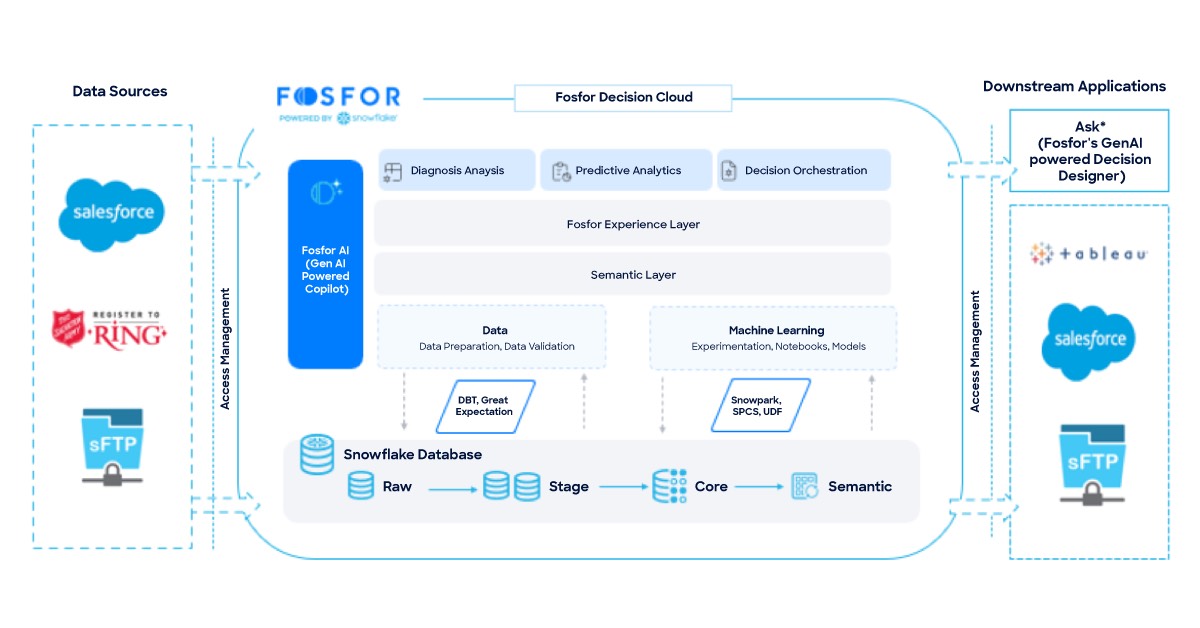 Reading Time: 6 minutes
Reading Time: 6 minutesImagine a telecom company monitoring the internet usage of its customers. It then uses this data to increase the network bandwidth and reduce the energy utilization for its delivery. It is a win-win scenario – for the company and the environment. The company is able to enhance customer service while minimizing energy consumption. It is a perfect example of how organizations can use their data for good.
Through the application of advanced data analytics across their data lifecycle, organizations can derive meaningful insights and convert them into positive social impact – the scope of data is extended beyond for-profit metrics and helps transform lives and even the planet.
There are numerous forms that “data for good” takes. A fashion brand can use its data to improve sustainability practices across its supply chain and reduce environmental impact. A pharmaceutical or healthcare company can enhance the accessibility and affordability of its medicines or services by evaluating social metrics. A nonprofit organization (NPO) can maximize its program effectiveness and fundraising efforts by understanding its data better.
Essentially, a data-for-good approach empowers enterprises to meet several goals, from environmental, social, and governance (ESG) to corporate social responsibility (CSR), and sustainability. Fosfor has been a committed partner in helping organizations use their data for good. One such remarkable example is how we helped The Salvation Army (TSA), an international charitable organization, transform its donor engagement by solving its data management challenges.
Fosfor+Snowflake: Revolutionizing donor management for The Salvation Army
The Salvation Army (TSA) has served communities in the USA for over 150 years. It has around 1.9 million members and volunteers in the country and serves nearly 24 million Americans annually. In 2022 alone, it raised over $2 billion to fund food, shelter, utility assistance, and several other programs. Being a large organization with such an expansive reach, the TSA deals with large volumes of data. Managing this data is crucial for the efficient allocation of resources and amplifying the impact of programs.
Fosfor helped TSA solve its data management challenges and revamped its donor engagement
When the TSA approached us, we observed that they faced problems in the overall digital transformation of their operations: outdated infrastructure, lack of real-time data updates, high resource utilization costs, and poor data quality. It was crucial to effectively address these challenges as each one of them comes with its own ramifications.
An outdated infrastructure limits data storage and processing capacity, restricts data accessibility, reduces integration potential with new technologies, and increases security risks. As a cascading effect, the availability of real-time data updates becomes severely limited. This leads to slower response time in the deployment of resources, limited monitoring of program performance, inefficient resource allocation, and loss of fundraising and donor engagement opportunities.
High resource utilization costs result in the inefficient delivery of program benefits, which in turn leads to negative perception among donors and reduced contributions. They also limit program scalability and flexibility, leaving a limited budget for spending on current programs or implementing new ones.
Finally, poor data quality serves as a roadblock throughout the data-to-decisions journey. From resource allocation to developing program strategies, decisions based on poor data can result in resource wastage. This not only leads to financial losses but also a loss of reputation – inconsistent or unreliable data reporting leads to a loss of trust, hurting the NPO’s reputation.

Laying an AI-ready data foundation on Snowflake
When it comes to unlocking the value of an enterprise’s data, the partnership between Fosfor and Snowflake is a game-changer. Through our collaboration, we empowered TSA to overcome its data management challenges. We combined the Fosfor Decision Cloud’s GenAI capabilities with the Snowflake Data Cloud’s cloud-native features to build reliable pipelines.
First, the organization’s multi-source data had to be tackled. The Fosfor Decision Cloud was implemented to streamline its Extract, Load, and Transform (ELT) process. Next, Snowflake was seamlessly integrated to address data storage and downstream reporting requirements.


Modernized data management enhanced donor engagement
The solution combined the best of the Fosfor Decision Cloud and the Snowflake Data Cloud to enhance donor management for TSA. The modular, flexible platform accessible from any location served as a single source of truth, giving the organization better visibility of donor programs, optimized processes on cloud, and democratized insights at speed and scale. Some of its significant benefits were:
- Enhanced visibility: Improved data transparency empowered data-driven decisions by the sales, marketing, and technology teams.
- Reduced time-to-insight: Accelerating analysis and insights from donor engagement programs facilitated quicker decision-making and resource allocation.
- Cost savings and increased productivity: Snowflake’s flexibility optimized data prior to ingestion into Tableau and increased workbook efficiency, resulting in up to a 30% cost reduction.
The solution helped house 15 TB of historical data on Snowflake with 200 GB of daily refresh. Additionally, it improved data-related process execution times by 55% and provided for a ~3X expected increase in donor program engagement.
Real-world possibilities
The benefits experienced by TSA can be translated to any organization and field – the possibilities of data’s use for good are limitless. A few use cases are:
1. Geographical data for resource allocation
Geographical data can be used to uncover patterns and actionable insights that can serve communities in causes such as fighting food insecurity. Organizations devoted to hunger relief can use data to identify areas with the highest food insecurity rates. This can help in the effective allocation of resources, resulting in a substantial decrease in food wastage, increased donor revenue, and successful fundraising.
2. Real-time insights for decision-making
The continuous flow of data can be used to gain real-time, actionable insights on critical issues such as protecting threatened and endangered species. Real-time data on wildlife sightings and illegal activities can help wildlife protection agencies improve patrolling by providing insights into critical routes and sensitive areas. A data-driven approach can help safeguard and increase the population of at-risk species.
3. A single pane of glass for problem-solving
The consolidation of data into a central, unified view can simplify how we tackle complex issues. For example, it can enable donors of educational organizations to directly identify schools in need of resources. The collection of school data on a centralized platform can provide donors with actionable insights into the immediacy of fund requirements across functions. It can also provide policymakers insights into areas within the education system that need prompt addressing.
Recently, Fosfor worked with GoldenSource, an enterprise data management leader, to help Financial Services companies analyze their ESG initiatives. Analyzing their data on a single pane of glass helped them delve deeper into the factors causing the most emissions and identify consumer discretionary as the prime cause. They were also able to pinpoint the geographies with the highest recent increase in contribution to emissions – the US and Europe. Moreover, they observed that while companies were becoming more greenhouse gas efficient in their own operations, the suppliers’ emission contribution had increased. Companies could now increase their regulatory focus on the supply chain, make necessary course corrections, and continue to use data for good.
A future of data-driven change
The adoption of data analytics provides organizations with a springboard to adopt new technologies that elevate their data-for-good strategy.
For example, GenAI can transform how organizations engage with their customers. It can help them analyze customer data and ascertain the ESG or CRS expectations that they have from a brand or company. GenAI can help them craft messages specifically targeted at individual customers to create awareness about the organization’s initiatives and help them get actively involved.
NLP could power volunteer matching for NPOs. By analyzing volunteer preferences and skills with the needs of a program, the right volunteer can be assigned to the right program. This will enhance volunteer engagement and retention and ensure that the programs are supported by the appropriate donors.
Predictive analytics can facilitate hyper-local interventions based on weather, hospitalizations, and social media activity to predict health scares and natural disasters. This could help a healthcare or pharmaceutical enterprise working towards public health improvement activate interventions at the local level with awareness campaigns and mobile vaccination drives, even before outbreaks occur.
In these ways, the confluence of data analytics, machine learning, and artificial intelligence, among other new and innovative technologies, could help organizations decipher everything about their communities using data and help them use data for good in the future as well.
The Fosfor Decision Cloud can empower enterprises to advance transformation and unleash their data’s power for good. If you want to witness first hand what the FDC can do for you, book a free trial here.








